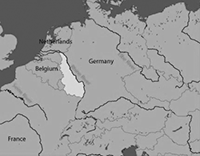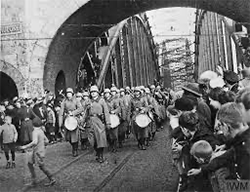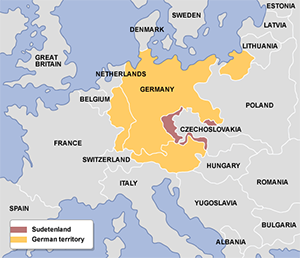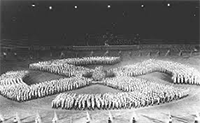Hitler by this time was Führer und Reichskanzler, chancellor of the Reich. He was the head of state and the commander-in-chief of the armed forces. One of his early acts was to alter the loyalty oath so that members of those armed forces pledged loyalty to him personally; this was a change from what had been an oath to be loyal to the state as embodied in its commander-in-chief. Hitler became commander-in-chief in function by ousting the existing head of the armed forces, War Minister Werner von Blomberg, who had refused to upgrade the military so that it would be ready to fight a war by 1938. Dozens of other top soldiers, including army commander Colonel-General Werner von Fritsch, lost their positions as well. When Hitler became Chancellor, in January 1933, the head of state was the President, who had a Cabinet consisting of the Chancellor, Vice-Chancellor, and 10 Reichsministers, heading up responsibilities in the departments of Economics, Finance, Food & Agriculture, Foreign Affairs, Interior, Labor, Postal, Reichswehr, and Transport. The government eliminated the position of Vice-chancellor on Aug. 7, 1934. Before and after, the Reichsministers personnel changed, as membership in the Nazi Party became a requirement. (Most of the original Cabinet were not.) As well, Hitler added new departments, notably the Ministry of Public Enlightenment and Propaganda, headed by Joseph Goebbels; the Aviation Ministry, led by Hermann Göring; the Ministry of Armanents and Munitions; and the Ministry of Science, Education and Culture. The last meeting of the full Cabinet took place on Feb. 5, 1938. As the years passed and the war progressed, the government operated more and more by decree. A series of laws dismantled the strong system of courts and legal codes that had existed under the Weimar Republic. The government in 1934 established the Volksgerichtshof (People's Court), which served mostly to convict state enemies of treason and, in many cases, sentence them to death. In late 1933, Germany withdrew from the League of Nations and from the World Disarmament Conference. The country was already working toward rearming, pursuing a large-scale investment in the building of weapons and machinery; as well, the government provided funding for infrastructure upgrades, in the form of road and railroad construction and upgrade. 
The Great Depression was still gripping Germany, and one of the ways that the government financed such projects was through a series of Mefo bills, which were a way to subvert the Treaty of Versailles prohibitions against rearming and the financing thereof. The government created a company named Metallugrische Forschungsgesellshaft, which was shortened to MEFO or Mefo. The company issued the equivalent of a loan to the government that had to be paid back after a period of six months, unless the company extended the "loan" period. Somehow, each and every time the company extended the period of the "loans," allowing the government to finance large-scale building of weapons, buildings, and infrastructure at a time when other European countries were struggling to feed their populations. By 1935, Germany was openly rearming, building weapons of many varieties, in clear violation of the terms of the Treaty of Versailles. The country was no longer a member of the League of Nations, which did not have a means of forcing its members to comply with directives, anyway. Protests against Germany's rearming were few and far between, and so Hitler and his government continued to drive the people and the economy toward being able to prosecute a war. 

In March 1936, German armed forces regained military control of the Rhineland, a part of Germany that it had agreed to keep unpatrolled as part of the terms of the war-ending Treaty and had reaffirmed in the Locarno Treaties of 1925. The occupation force numbered some 20,000 troops. They were met with applause by many of the people living there. Europe at that time was already embroiled in other crises. Italy had invaded Abyssinia the year before, and the response from the League of Nations was to impose sanctions against the aggressor. Also in 1935, France and the Soviet Union had agreed on a treaty aimed at containing any German military threat. Hitler's response to those two sets of events was to embrace the Italian leader, Benito Mussolini, and his invasion and to send troops into the Rhineland with the intention of staying. The rationalization from the German government was a defense against suspected enemies. In fact, Hitler publicly proposed returning Germany to the League of Nations and committing Germany to a path of peace if the other major European powers agreed that the punishments doled out to Germany by the Treaty of Versailles were too severe and unwarranted. No such agreements came; that Germany was also committing major manpower and money to rearming suggested that such promises were at best disingenuous. Also in 1936, Germany agreed to send troops to support the government of Spanish leader Francisco Franco in the Spanish Civil War. In November of that year, Germany signed agreements with both Italy and Japan; this was the beginnings of what became a military alliance. Germany solidified the initial agreement with Japan in February 1938 by renouncing an existing agreement with China, recognizing Japan's takeover of Chinese Manchuria and releasing German claims on former colonies in the Pacific, leaving Japan free to secure. In March 1938, German troops in the thousands marched peacefully into Austria and occupied it. This event, known as the Anschluss, caused great alarm throughout Western Europe. Many in Austria, however, welcomed the move, citing the long common history of the two countries, as both common elements of the Holy Roman Empire and as recent allies during World War I. 
Later that same month, Hitler and his government made public Germany's desire to annex the Sudetenland, a part of Czechoslovokia that was home to a great many Germans. This was an extension of the doctrine of Lebensraum ("living space") that Hitler and others espoused as necessary for German people to have. An alarmed U.K. Prime Minister Neville Chamberlain and French Prime Minister Édouard Daladier met with Hitler in Munich, Germany, on September 29. The resulting Munich Agreement, completed the following day, gave Hitler and Germany what they wanted–the Sudetenland–and the other nations got only Hitler's promise that he had no further territorial ambitions. (Also attending the Munich conference and representing Italy was Mussolini.) In the next few weeks, Czechoslovakia, which had existed only since the end of the World War I, ceded more and more of its lands to other countries, among them Hungary and Poland. In March 1939, German troops entered what remained of the First Czechoslovak Republic, occupying it completely. |
|
Social Studies for Kids
copyright 2002–2026
David White



 Hindenburg battled cancer but lost, dying on Aug. 2, 1934. The day before, Hitler and his Cabinet had passed a law abolishing the office of President and merging its powers with that of the Chancellor. When Hindenburg died, the republic died as well. In its place was a Germany run and increasingly controlled and dominated by Hitler and the Nazi Party.
Hindenburg battled cancer but lost, dying on Aug. 2, 1934. The day before, Hitler and his Cabinet had passed a law abolishing the office of President and merging its powers with that of the Chancellor. When Hindenburg died, the republic died as well. In its place was a Germany run and increasingly controlled and dominated by Hitler and the Nazi Party.
